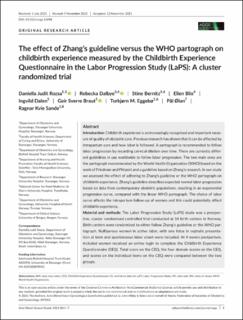| dc.contributor.author | Rozsa, Daniella Judit | |
| dc.contributor.author | Dalbye, Rebecka | |
| dc.contributor.author | Bernitz, Stine | |
| dc.contributor.author | Blix, Ellen | |
| dc.contributor.author | Dalen, Ingvild | |
| dc.contributor.author | Braut, Geir Sverre | |
| dc.contributor.author | Eggebø, Torbjørn Moe | |
| dc.contributor.author | Øian, Pål | |
| dc.contributor.author | Sande, Ragnar Kvie | |
| dc.date.accessioned | 2022-01-20T08:57:57Z | |
| dc.date.available | 2022-01-20T08:57:57Z | |
| dc.date.created | 2021-12-10T19:17:39Z | |
| dc.date.issued | 2021-12-02 | |
| dc.identifier.citation | Acta Obstetricia et Gynecologica Scandinavica. 2021, 1-7. | en_US |
| dc.identifier.issn | 0001-6349 | |
| dc.identifier.issn | 1600-0412 | |
| dc.identifier.uri | https://hdl.handle.net/11250/2838409 | |
| dc.description.abstract | Introduction: Childbirth experience is an increasingly recognized and important measure of quality of obstetric care. Previous research has shown that it can be affected by intrapartum care and how labor is followed. A partograph is recommended to follow labor progression by recording cervical dilation over time. There are currently different guidelines in use worldwide to follow labor progression. The two main ones are the partograph recommended by the World Health Organization (WHO) based on the work of Friedman and Philpott and a guideline based on Zhang’s research. In our study we assessed the effect of adhering to Zhang’s guideline or the WHO partograph on childbirth experience. Zhang’s guideline describes expected normal labor progression based on data from contemporary obstetric populations, resulting in an exponential progression curve, compared with the linear WHO partograph. The choice of labor curve affects the intrapartum follow-up of women and this could potentially affect childbirth experience.
Material and methods: The Labor Progression Study (LaPS) study was a prospective, cluster randomized controlled trial conducted at 14 birth centers in Norway. Birth centers were randomized to either follow Zhang’s guideline or the WHO partograph. Nulliparous women in active labor, with one fetus in cephalic presentation at term and spontaneous labor onset were included. At 4 weeks postpartum, included women received an online login to complete the Childbirth Experience Questionnaire (CEQ). Total score on the CEQ, the four domain scores on the CEQ, and scores on the individual items on the CEQ were compared between the two groups.
Results: There were 1855 women in the Zhang group and 1749 women in the WHO partograph group. There was no difference in the total or domain CEQ scores between the two groups. We found statistically significant differences for two individual items; women in the Zhang group scored lower on positive memories and feeling of control.
Conclusions: Based on our findings on childbirth experience there is no reason to prefer Zhang’s guideline over the WHO partograph. | en_US |
| dc.language.iso | eng | en_US |
| dc.publisher | Wiley Open Access | en_US |
| dc.relation.ispartofseries | Acta Obstetricia et Gynecologica Scandinavica; | |
| dc.rights | Attribution-NonCommercial-NoDerivatives 4.0 Internasjonal | * |
| dc.rights.uri | http://creativecommons.org/licenses/by-nc-nd/4.0/deed.no | * |
| dc.subject | Childbirth experiences | en_US |
| dc.subject | Labor progression | en_US |
| dc.subject | Obstetric care | en_US |
| dc.subject | WHO partographs | en_US |
| dc.subject | Labor progression guidelines | en_US |
| dc.subject | Zhang’s guideline | en_US |
| dc.title | The effect of Zhang’s guideline versus the WHO partograph on childbirth experience measured by the Childbirth Experience Questionnaire in the Labor Progression Study (LaPS): A cluster randomized trial | en_US |
| dc.type | Peer reviewed | en_US |
| dc.type | Journal article | en_US |
| dc.description.version | publishedVersion | en_US |
| dc.rights.holder | © 2021 The Authors | en_US |
| cristin.ispublished | true | |
| cristin.fulltext | original | |
| cristin.qualitycode | 1 | |
| dc.identifier.doi | https://doi.org/10.1111/aogs.14298 | |
| dc.identifier.cristin | 1967282 | |
| dc.source.journal | Acta Obstetricia et Gynecologica Scandinavica | en_US |
| dc.source.pagenumber | 1-7 | en_US |

